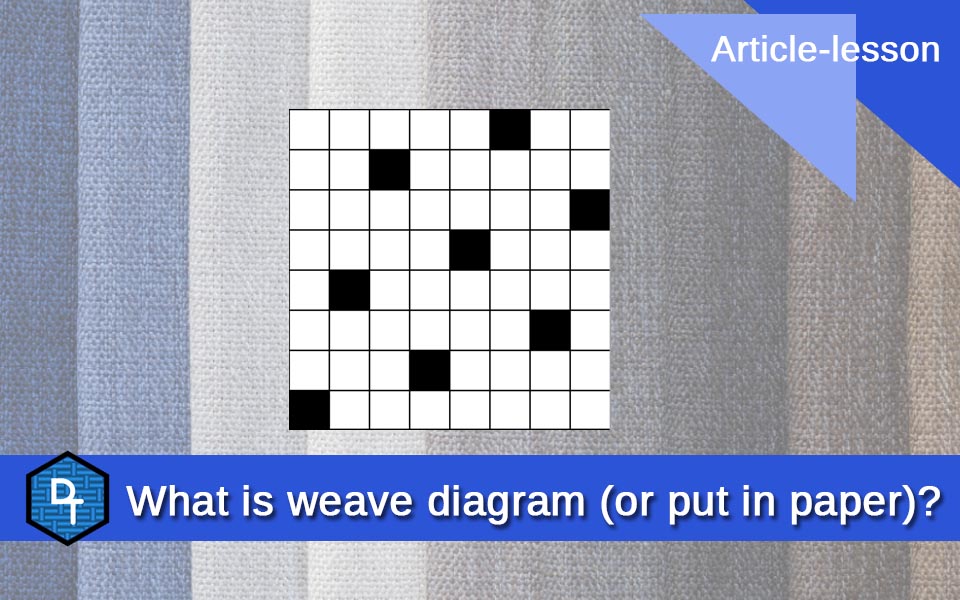Your cart is currently empty!
FREE Lesson 4 – What is weave diagram (or put in paper)?

FREE Lesson 4 – What is weave diagram (or put in paper)?
Answering the question, What is “weave diagram” or “put in paper”? It might be in its definition easy enough to say.
But since in this article-lesson, I want to explore a bit more, I won’t stop at just a definition of it.If perhaps you’ve already read my previous article-lesson, in which I explained in detail what the basics of creating a fabric are (you can read it by clicking HERE), you’ll find it easier to understand the usefulness and use of weave diagram, which is basically a procedure, but also a more physical “something”. It’s basically terminology that can be used in two ways.
If you think about it “weave diagram” or “put in paper”, is a terminology in itself very clear and at the same time “mysterious”.
Reading these words: “weave diagram” or more from italian language, how we are abit to talk “put in paper”, without even knowing what you are talking about, you might think it is about something that is put on paper, right?
In fact that’s exactly how it is, or rather originally it was, today it’s a little different.
But what is, or was, “put in paper” or “weave diagram” ?
Logically because we talking about weaving, it is something about the subject, certainly not talking about something in general!Well, now and after this premise a bit long, to introduce you to the subject, I start to give you a first definition of “waves diagram”, or “put in paper”, let’s say the one concerning the procedure:
“Put in paper” is that operation that the textile technician performs in order to represent on paper (a kind of code), the interweaving of the vertical threads with respect to the horizontal ones of a fabric, also called weaving.If you look at a fabric very closely, perhaps using a magnifying glass, you will realize that it is normally NOT like a sheet of paper (i.e. a flat, continuous surface).
In reality (although there are various techniques for making a fabric, and there are even fabrics called “faux”), fabric is a collection of vertical and horizontal threads that intertwine with each other, and this forms what we all call fabric.
Which then forms the basis of all the clothing and textile artifacts we use every dayAnd now we come to the second definition of “put in paper” or “waves diagram”, which is, however, totally connected to the first:
“Put in paper” is also the design, or graphic code that represents (precisely on paper), through the use of black and white squares, the weaving of a fabric.
So, as you can see, “put in paper” can have this double meaning, even if normally in the books that are studied (and that I have studied), in schools that teach weaving, only this second definition is generally used.
But for a particularly in-depth analysis, I believe after many years of experience, that the “put in paper” is better explained with this double meaning, which I think is even more complete.You should now have come to sufficiently understand the concept.
But why was this procedure/design devised?The simplest reason is very similar conceptually to why at some point human beings felt the need to invent writing:
To be able to have a fairly simple means of “describing”, in this case a fabric, and subsequently being able to reconstruct it by means of special machinery (the looms), and also to be able to archive it and allow other people to be able to “pass it on”, know about it and use it.Below I’ll show you two images, the one on the left represents a drawn “enlargement” of a simple fabric, and on the right you’ll find the “put in paper” that represents it.

But how do you read the black squares and the white squares to understand how to weave/reconstruct a fabric through the “put in paper” or “weaves diagram”?
The concept is really very, very simple.
- When a square is colored black it means that the vertical thread (called warp), passes over the horizontal thread (called weft).
- When the square is white it means that the vertical thread (warp)under the horizontal thread (weft)
Therefore the set of black and white squares defines with simplicity but with extreme precision how a fabric evolves in its weave and in this way, as when we read a book, we can “read” and make the looms weave the corresponding fabric.
If you’ve made it all the way through this article-lesson, you should now have a very good understanding of what “put in paper” or “waves diagram” is, and also what it’s for.
Yes, because the “put in paper” has many other rules to follow in order to be used to represent and reconstruct particularly complex fabrics.
But we will see all this a little at a time, in the next articles-lesson.See you soon in the next article-lesson!
If you think this article-lesson might be of interest to someone else you know, share it and you’ll be doing them a favor!